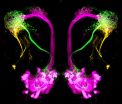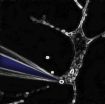A beetle named Marco Polo
2014-12-16
(Press-News.org) A team of Chinese and Italian scientists has joined efforts to provide a key to the understudied phaleratus group of blister beetles. During their research the scientists have also discovered a new species from the genus Hycleus, which they named after Marco Polo, as a tribute to their collaboration during the Ph.D. studies. The study was published in the open access journal ZooKeys.
The phaleratus group to which the new species Hycleus marcipoli belongs, is part of the Meloidae family commonly known as the blister beetle family. The representatives of this group get their unpleasant name from their defensive mechanism which includes secretion of a blistering agent.
The name of the new species was inspired by the Chinese - Italian collaboration during this research. Marco Polo (1254-1324), was a Venetian explorer who, during a long period of permanence F in China in the late XIII century (1271-1284), established the first well documented relationships between the Chinese and European worlds and opened western culture to the wide and rich Chinese heritage.
"We were extremely happy to discover a new species during our studies of the Chinese species of the genus Hycleus. We were wondering for a while how to name it until we came up with the idea to name it after Marco Polo a historical figure which represents the beginning of collaboration between China and the West. " comments Dr Marco A. Bologna from the Università degli studi Roma Tre, Italy.
INFORMATION:
Original Source:
Pan Z, Monica C, Bologna MA (2014) A new Eastern Asian Hycleus and key to the Chinese species of the phaleratus group (Coleoptera, Meloidae, Mylabrini). ZooKeys 463: 11-19. doi: 10.3897/zookeys.463.8261
[Attachments] See images for this press release:

ELSE PRESS RELEASES FROM THIS DATE:
2014-12-16
This news release is available in German. Whether an odor is pleasant or disgusting to an organism is not just a matter of taste. Often, an organism's survival depends on its ability to make just such a discrimination, because odors can provide important information about food sources, oviposition sites or suitable mates. However, odor sources can also be signs of lethal hazards. Scientists from the BMBF Research Group Olfactory Coding at the Max Planck Institute for Chemical Ecology in Jena, Germany, have now found that in fruit flies, the quality and intensity of ...
2014-12-16
Researchers studied 414 people with severe dementia along with their carers in England, Estonia, Finland, France, Germany, the Netherlands, Spain and Sweden. The study gathered information on quality of life, activities of daily living such as bathing, feeding and dressing and presence of depressive symptoms using standardised measures.
In the groups studied, 37% of the 217 people living in the community showed signs of depression compared to 23% of the 197 in care homes. It is one of the few studies comparing similar groups of people living at home and in nursing homes.
Professor ...
2014-12-16
Some neurons are more active than others, even when they are positioned right next to each other and are one and the same neuron type. Dr. Jean-Sébastien Jouhanneau and Dr. James Poulet of the Max Delbrück Center for Molecular Medicine (MDC) Berlin Buch have discovered the cause for this phenomenon. They found that the more active neurons in the somatosensory area of the brain respond to a broader receptive field and probably play a particularly important role in our sensory perception. The findings of the researchers, who also work at the NeuroCure Cluster of ...
2014-12-16
People and animals have been shown to discriminate between quantities. Lions, chimpanzees and hyenas, for example, will only approach a group of attackers if their own group outnumbers that of the intruders. These animals use numerical information to make decisions about their social life.
Testing numerical competence
In 2012 Friederike Range and Zsofia Virányi from the Messerli Research Institute at the University of Veterinary Medicine Vienna showed that wolves are capable of discriminating between different food quantities. In their present study, they asked ...
2014-12-16
Stimulants use such as cocaine and amphetamine is associated with a nearly two-fold greater likelihood of suicidal behaviour amongst people who inject drugs, say researchers at the University of Montreal and the CHUM Research Centre. Drug addiction had already been identified as a major risk factor for suicide, and it is in fact the cause of ten percent of deaths among drug users. The data from this groundbreaking study could help develop and evaluate more appropriate suicide prevention efforts in this highly vulnerable population.
The researchers were able to explore ...
2014-12-16
GPs should consider a more overt discussion with patients when referring them for further investigation of symptoms which may indicate cancer, according to a paper published in the British Journal of General Practice.
In an NIHR-funded study, researchers from the Universities of Bristol, Cambridge, Durham and Exeter conducted interviews with patients being referred for possible lung and colorectal cancer.
They found that patients were rarely involved in the decision to be referred for investigation and that reasons for referral tended to be couched in non-specific ...
2014-12-16
WASHINGTON, Dec. 16, 2014 -- It's been a holiday decoration staple for decades, and it turns out that silver stuff hanging from your tree has quite a storied past. Tinsel has been made out of everything from real silver, to lead to other dangerously flammable materials. This week's Speaking of Chemistry decks your halls with the history of tinsel. Check it out at http://youtu.be/fql3aCuu1l0.
INFORMATION:
Speaking of Chemistry is a production of Chemical & Engineering News, a weekly magazine of the American Chemical Society. The program features fascinating, weird and ...
2014-12-16
University of Guelph researchers hope their new discovery will help combat a disease killing honeybee populations around the world.
The researchers have found a toxin released by the pathogen that causes American foulbrood disease -- Paenibacillus larvae (P. larvae) -- and developed a lead-based inhibitor against it.
The study was published in the December issue of the Journal of Biological Chemistry.
The finding provides much-needed insight into how the infection occurs, said Rod Merrill, a professor in Guelph's Department of Molecular and Cellular Biology and a ...
2014-12-16
PROVIDENCE, R.I. [Brown University] -- Newly published research provides the first demonstration of how a genetic mutation associated with a common form of albinism leads to the lack of melanin pigments that characterizes the condition.
About 1 in 40,000 people worldwide have type 2 oculocutaneous albinism, which has symptoms of unsually light hair and skin coloration, vision problems, and reduced protection from sunlight-related skin or eye cancers. Scientists have known for about 20 years that the condition is linked to mutations in the gene that produces the OCA2 protein, ...
2014-12-16
JACKSONVILLE, Fla. -- It may not be necessary for experienced gastroenterologists to send polyps they remove from a patient's colon to a pathologist for examination, according to a large study conducted by physician researchers at the Jacksonville campus of Mayo Clinic.
Their 522-patient study, published in the December issue of Gastrointestinal Endoscopy, found that physicians correctly evaluated whether a polyp was precancerous or benign using high-definition optical lenses during a colonoscopy. Their assessment was 96 or 97 percent accurate -- depending on which of ...
LAST 30 PRESS RELEASES:
[Press-News.org] A beetle named Marco Polo




